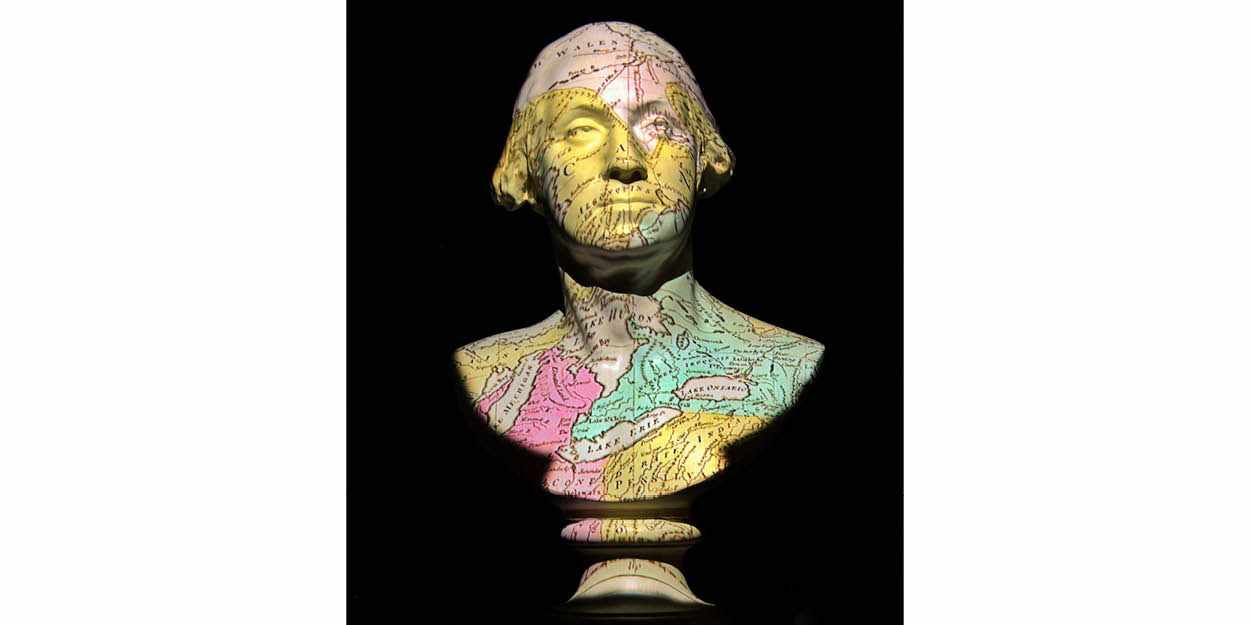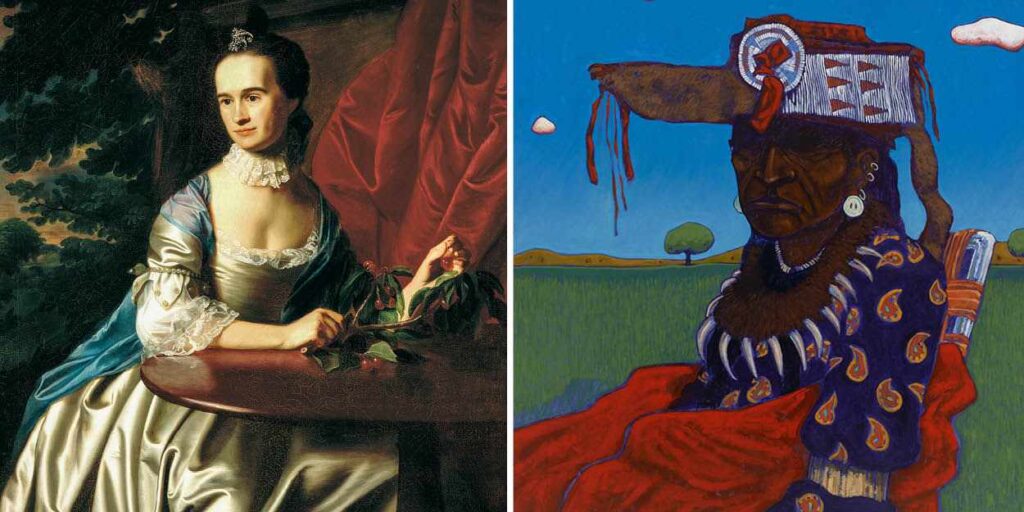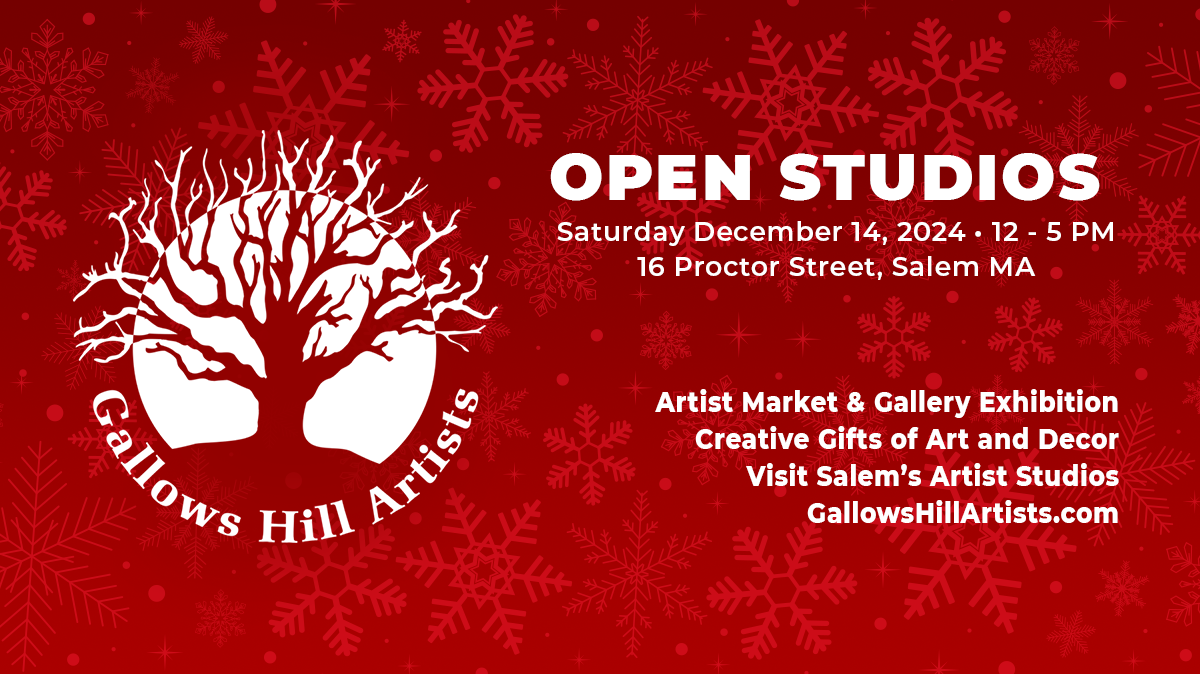
This winter, the Peabody Essex Museum (PEM) opens a new gallery that, for the first time, combines its Native American and American collections. On This Ground: Being and Belonging in America brings together more than 250 historical and contemporary works from its collections to consider what it means to belong to a community, place, family and nation. Spanning more than 10,000 years of visual culture, the installation offers a range of voices and modes of expression, cultures expressed through different media, including sculpture, paintings, textiles and fashion, furniture, decorative arts, photography and video. Throughout, aesthetic affinities emerge across time, cultures, and geography. On This Ground is responsive to the urgent concerns of our time and provides an opportunity to grapple with our nation’s complex history while striving for a future that brings more connection and empathy. This groundbreaking installation opens to the public on March 12, 2022.
“Placing these two significant collections in direct dialogue and giving them equal emphasis and gallery space at this scale is unprecedented among American museums and underscores that the American experience is unimaginable without the inclusion of Native American art, history and culture,” said Lynda Roscoe Hartigan, PEM’s Rose-Marie and Eijk van Otterloo Executive Director and CEO.
Since its founding in 1799, PEM has continually collected and exhibited Native American art from its collection, which is among the oldest in the western hemisphere and world-renowned for its outstanding quality, condition, provenance, span of time, media, and geography. PEM’s American art collection showcases four centuries of artistic traditions to tell stories of American life and the ongoing cultural exchange between the nation and the wider world. The museum was among the first in the country to collect decorative arts, including furniture, interior furnishings, and everyday objects that reflect the material culture and life experiences of New England. More recently, initiatives to collect contemporary works across diverse media have resulted in a wider representation of American art and culture through the 21st century.

Explorations of Place and Identity
The installation begins with a video of Massachusett Tribe at Ponkapoag community elder, Elizabeth Solomon, to welcome visitors and to share how the Massachusett have — despite thousands of years of natural and human-made changes — an unbroken connection to this place now known as Salem. Solomon reminds us that wherever you are in the Americas, you are on Native land, a concept underscored by an adjacent stone bear sculpture made by a 17th century Pawtucket artist. The introduction also includes the original Massachusetts Bay Charter (1629), on loan from the Salem Athenaeum as well as a poem by National Youth Poet Laureate, Amanda Gorman, whose work brings forward a chorus of voices that comprise America, illuminating defining moments and unsung heroes with empathy and hopefulness. Together, these elements invite us to consider the beginning of American self-governance, religious freedom, political authority, and the power of creative expression.
American artists have long mythologized European early contact and the settling of America. Two paintings investigating the iconic places where English pilgrims landed are installed in conversation with commissioned portraits of Wampanoag community members, made by Diné photographer Will Wilson. The continued presence of the Wampanoag shines through in Wilson’s Critical Photographic Exchange project, a series of luminescent tintypes produced in collaboration with the sitters. Wilson’s portraits join over 70 works by modern and contemporary artists, including Will Barnet, Steve Locke, Truman Lowe (Ho-Chunk), Georgia O’Keeffe, Cara Romero (Chemehuevi), Alison Saar, Hank Willis Thomas, and Kay WalkingStick (Cherokee Nation).
“One of the goals of this installation is to deepen the appreciation of Indigenous aesthetics across time and space, and also to provide a bridge between the disciplines of Native American and American art, which have historically been separated,” said Karen Kramer, PEM’s Curator of Native American and Oceanic Art and Culture and project co-curator. “We are particularly excited by the transformative possibilities offered by bringing together different modes of aesthetic expression and cultural practice.”
Themes of Place and Identity are found throughout the installation, in sections where PEM’s Native American and American art works are combined or where each collection is considered on its own. The Native American art sections are rooted in Indigenous knowledges that emphasize ancestral connections among water, land, and the skyworld; Indigenous self-representation, storytelling, and fashion; and the continuum between past, present and future. The American art sections focus on landscapes; the international connections and influences of Salem artists over the last 400 years; and a close look at how objects contain layers of meaning about individual and collective identity in America.

“The project recognizes power dynamics that extend from historical events into the present and foregrounds a multiplicity of American stories and voices in order to create a broader and more nuanced understanding of our histories,” said Sarah Chasse, Associate Curator and project co-curator. “Many contemporary works in the installation ask us to consider whose stories have defined America and whether we are ready to acknowledge new stories.”
PEM’s Native American and American art collections converge across the installation and prompt new ways of looking at the past by exploring historical figures, events, and ideas. From religious persecution and the conflicts over North American land in the 17th and 18th centuries, to slavery, migration, and westward expansion, artists at turns create and disassemble national mythologies and challenge the notion of a single, unified American experience. In addition to object groupings that look deeply at the legacies of colonization, On This Ground offers lighter moments of joy, humor, and visual pleasure. Themes of place, women’s identity, and generational bonds across cultures provide a fresh look and surprising juxtapositions.

Process and Collaboration
Collaboration has been at the heart of this installation project since its inception. PEM staff convened with scholars from across the fields of Native American and American art to consider approaches for integrating the collections, and how to augment and amplify historical and artistic intersections. Throughout the project, PEM’s Native American Fellows (2018-2021) collaborated on the project through workshops, and curatorial and interpretive research. Curatorial staff developed interactive sketchbook stations for visitors to share drawings, reflections, and responses. Additionally, in the galleries, visitors will see 30 wall labels contributed by a range of scholars, artists, community members, activists, and poets who offer interpretation that expands beyond the museum’s curatorial voices to explore gallery themes and personal connections to objects.
Resonance and Reflection
A display of archaeological stone tools dating back 10,000 years from the Bull Brook site in current-day Ipswich, Massachusetts, reminds us as a closing moment of the installation that we are on Indigenous land where place and identity have been cultivated for many generations.
On This Ground: Being and Belonging in America was made possible by the Henry Luce Foundation, the Terra Foundation for American Art and The Andrew W. Mellon Foundation. All three foundations have sponsored projects across the nation that push for an expanded canon of American art and for initiatives that support the arts and humanities through a social justice lens.
SPONSORS
On This Ground: Being and Belonging in America is supported by a major grant from the Henry Luce Foundation. Additional generous support has been provided by the Terra Foundation for American Art. We gratefully acknowledge the Ellen and Stephen Hoffman Endowment for the Native American Art Department and The Andrew W. Mellon Foundation for their support of the Native American Fellowship Program.
ABOUT THE HENRY LUCE FOUNDATION
The Henry Luce Foundation seeks to enrich public discourse by promoting innovative scholarship, cultivating new leaders, and fostering international understanding. Established in 1936 by Henry R. Luce, the co-founder and editor-in-chief of Time, Inc.,the Luce Foundation advances its mission through grantmaking and leadership programs in the fields of Asia, higher education, religion and theology, art, and public policy. A leader in art funding since 1982, the Luce Foundation’s American Art Program supports innovative museum projects nationwide that advance the role of visual arts of the United States in an open and equitable society, and the potential of museums to serve as forums for art-centered conversations that celebrate creativity, explore difference, and seek common ground. The Foundation aims to empower museums and arts organizations to reconsider accepted histories, foreground the voices and experiences of underrepresented artists and cultures, and welcome diverse collaborators and communities into dialogue.
ABOUT THE TERRA FOUNDATION FOR AMERICAN ART
The Terra Foundation for American Art supports individuals, organizations, and communities to advance expansive understandings of American art. Established in 1978 and headquartered in Chicago, with an office in Paris, the Terra Foundation is committed to fostering cross-cultural dialogues on American art locally, nationally, and internationally, through its grant program, collection, and initiatives.
ABOUT THE ANDREW W. MELLON FOUNDATION
The Andrew W. Mellon Foundation is the nation’s largest supporter of the arts and humanities. Since 1969, the Foundation has been guided by its core belief that the humanities and arts are essential to human understanding. The Foundation believes that the arts and humanities are where we express our complex humanity, and that everyone deserves the beauty, transcendence, and freedom that can be found there. Through our grants, we seek to build just communities enriched by meaning and empowered by critical thinking, where ideas and imagination can thrive.
Creative North Shore is Operated and Curated by Creative Collective
Creative Collective is a group of economic development strategists, small business supporters, activation specialists, and believers in the importance of the creative workforce. We foster growth, sustainability, and scalability for small businesses, creative thinkers, organizations, entrepreneurs, and innovators.
Learn more and join Creative Collective at www.creativecollectivema.com/join








